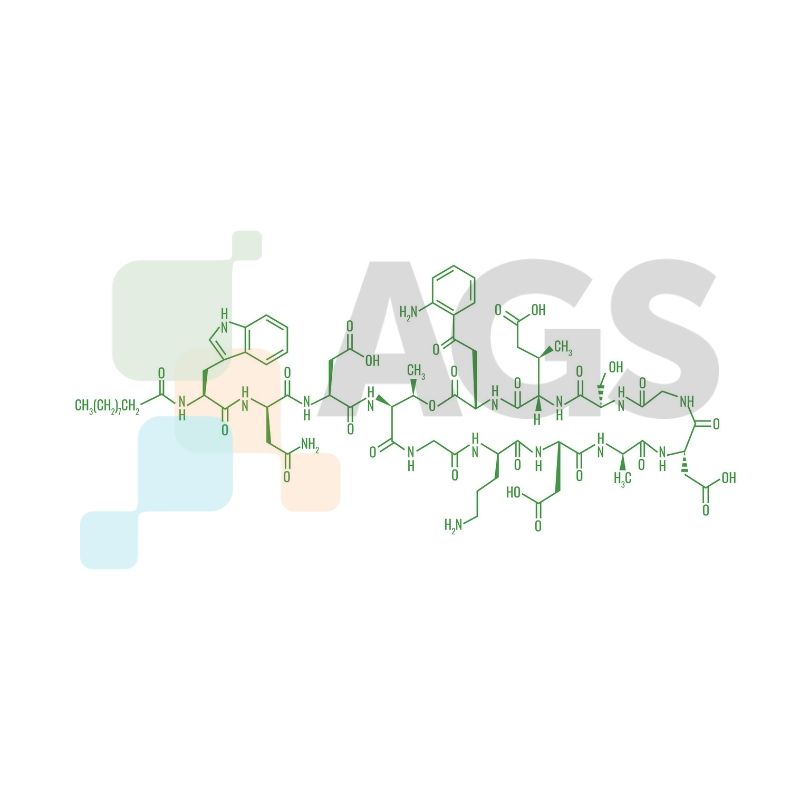For over 20 years, AG Scientific has been a leading supplier of Daptomycin. We offer a range of catalog sizes, as well as multi-kilogram quantities for bulk applications. Additionally, we provide a full range of services including bottling, sterile formulations, custom packaging, and comprehensive private labeling capabilities.
What is Daptomycin?

Daptomycin is a lipopeptide antibiotic and is a naturally occurring compound synthesized by Streptomyces roseosporus. Daptomycin is used in the treatment of certain infections caused by Gram-positive microbes. This includes: Bacillus, Listeria, Staphylococcus, Streptococcus, and Enterococcus. Due to a distinct mechanism of action, this drug may be useful in treating infections caused by multi-resistant bacteria.
What are the alternative names for this antibiotic?
In the United States, this antibiotic is marketed as Cubicin® by MERCK. Additionally, the compound is also known as LY146032, Cidecin, Daptomicina, Daptomycine, and Daptomycinum.What is the bio-structure of Daptomycin?
Daptomycin has thirteen amino acids: ten that are arranged in a cyclic form, and three that have an exocyclic tail. There are 2 non-proteinogenic amino acids that exist in the lipopeptide, called L-kynurenine (Kyn) and L-3-methylglutamic acid (mGlu).
What is the mechanism of action?
Daptomycin has a distinct mechanism of action that disrupts multiple aspects of bacterial cell membrane function. It binds to the membrane and causes rapid depolarization. This results in losing a potential membrane that leads to the inhibition of protein, DNA and RNA synthesis. Lastly it ends in bacterial cell death. This distinct mechanism of action may be useful in treating infections caused by multi-resistant bacteria.
Is this antibiotic used to treat MRSA?
Yes, Daptomycin can be used to treat MRSA (methicillin-resistant Staphylococcus aureus) - a Gram-positive bacteria.How is Daptomycin biosynthesized?
Biosynthesis is started by the following:- Coupling of decanoic acid to the N-terminal tryptophan
- Coupling of the remaining amino acids by non-ribosomal peptide synthetase (NRPS) mechanisms
- A cyclization event occurs, catalyzed by a thioesterase enzyme
- Release of the lipopeptide is granted
Does material need to be packaged under inert gas?
Yes, we package our Daptomycin under inert gas.What are the product specifications?
| Chemical Formula | C72H101N17O26 |
| CAS Number | 103060-53-3 |
| Appearance | Pale yellow powder |
| Purity | >95% (HPLC) |
| Molecular Weight | 1620.67 |
| Storage | Store at -20°C. Protect from moisture. |
| Melting Point | 268 - 271°C |
| Solubility | DMSO, Ethanol |
| pH | 4.0-4.5 |
What is the solubility of Daptomycin?
Daptomycin is soluble in methanol, DMSO, ethanol, and methanol. Limited solubility in water.What is the stability of this compound?
Daptomycin for treatment should be diluted with 0.9% sodium chloride. The injection is done by an IV infusion, over a period of 30 minutes. This product contains no preservative or bacteriostatic agent. An aseptic technique needs to be used in preparation of final IV solution.  A reconstituted solution can be stable in the vial for 12 hours at room temperature or up to 48 hours. However it needs to be stored under refrigeration at 2 to 8ºC (36 to 46ºF). A diluted solution is stable in the infusion bag for 12 hours at room temperature or 48 hours. The combined time at room temperature should not exceed 12 hours, nor 48 hours.
A reconstituted solution can be stable in the vial for 12 hours at room temperature or up to 48 hours. However it needs to be stored under refrigeration at 2 to 8ºC (36 to 46ºF). A diluted solution is stable in the infusion bag for 12 hours at room temperature or 48 hours. The combined time at room temperature should not exceed 12 hours, nor 48 hours.
What is the toxicological information for this antibiotic?
- Oral: no apparent adverse effects at dose levels up to 2,000 mg/kg
- Skin: Rabbit, 200 mg/kg, no deaths or toxicity
- Intravenous (IV):
- Rat, median lethal dose 151 mg/kg, coma, convulsions, tremors, incoordination, hindlimb paralysis, reduced activity.
- Dog, 200 mg/kg, no deaths, reduced body weight, reduced appetite, liver enzyme changes.
- Monkey, median lethal 25 mg/kg and 200 mg/kg, mortality, lethargy, ataxia, severe muscle weakness, pale facial skin, liver enzyme changes.
Additional Reading
- What Can Be Done to Fight Antibiotic Resistance?
- A Guide to the 8 Most Common Classes of Antibiotics
